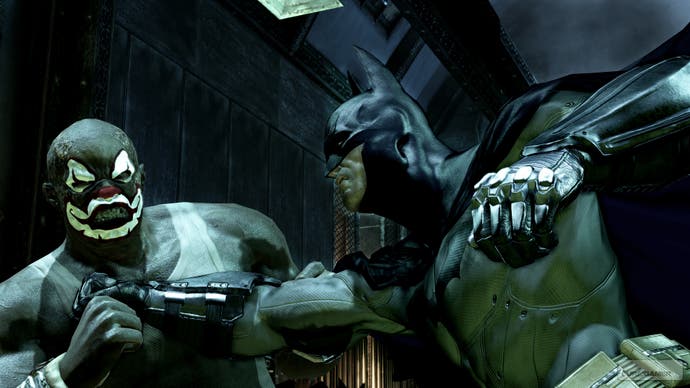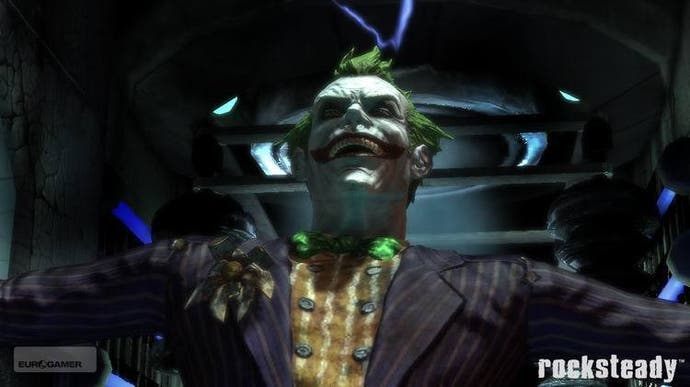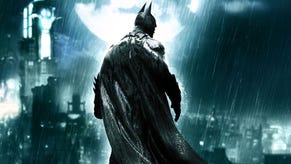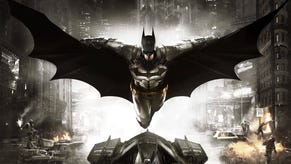Batman: Arkham Asylum
Batting for the right team.
I had the same reaction, when I heard about Arkham Asylum, as I did when I heard about the Watchmen game. A defensive reflex, based on the mistaken assumption that this new game was going to be a baffling gamification of Grant Morrison's excellent 1989 graphic novel. Developer Rocksteady is understandably keen to distance itself from that assumption. Arkham Asylum draws from more than one Batman, but it's definitely a DC Batman. Despite a fashionably darker look, Arkham Asylum has its strongest links with the excellent early 90s cartoon, Batman: The Animated Series.
It's a relief that I don't have to feel the same instinctive and dull outrage that Watchmen caused. Watchmen was a one-off, unique. It's so precious and complicated that Terry Gilliam claimed it'd be impossible to turn into a film, let alone a game. And Batman? Well, bless him, he's been ridden around more than a geriatric Blackpool donkey. The other, more fundamental distinction between the two games is that Arkham Asylum actually looks like it might be very good.
Rocksteady is aiming for the feel of titles like BioShock and Chronicles of Riddick, with the iconic asylum providing an atmosphere equally claustrophobic and imprisoning. The introduction we're shown starts off as a movie, as Batman drives Joker through the streets of Gotham. Batman's delivering him directly to Arkham, and he's gibbering about bombs under the city. His voice is familiar - it's veteran video-game bad guy Mark Hamill, who also voiced The Joker in The Animated Series. It's a longer, narrower Joker than TAS, though - Rocksteady has been working with DC's in-house Wildstorm studio to give the game characters a fresh feel.
We arrive at the Asylum, where the game - obviously - takes place. Everyone's keen to know if the whole of the game will be set in Arkham, especially considering the Joker's threats about bombs in Gotham. It appears not - some of the action will take place outside, on the island surrounding the prison. As if on cue, Batman says, "There are no bombs. He's lying. I know him."

His voice is familiar, for the same reason. Kevin Conway was the Batman opposite Mark Hamill's Joker. On top of that, Paul Dini - a TAS writer, story editor on Lost, and most impressively, Freakazoid - is back on board. So, it's a team that's worked together before, and Dini has been admirably humble about the job. As experienced a screenwriter as he is, he's happy to admit that this is his first videogame script, and has worked closely with Rocksteady to avoid the storytelling pitfalls that occur in games like Mirror's Edge, when storyline is treated as an entirely separate entity from gameplay.
Checking into Arkham, then, is a classic monorail ride, albeit without the monorail. Joker is clamped into a Hannibal Lecter-style trolley, and we're following him, getting a feel for this new, filthy-futuristic imagining of the prison. We all know something's coming, so the journey into the centre of the prison is a forbidding one. Not least because of Joker's wearying stream of quips, that alternates perfectly between making you laugh, and feel uneasy. "I preferred the good old cavity search," he laments, as the hi-tech scanners search him for weapons. "It was much more personal."

To our left, through a filthy metal grill, we see prisoners being herded through the corridors. Turns out that Gotham's Black Gate Prison has recently suffered a fire, and hundreds of thugs are being temporarily held in Arkham. This, it'll turn out, is all part of Joker's plan - and he's already got Harlequin in the security office. She's had the most radical overhaul from Wildstorm.
The gameplay begins when Joker springs his trap, and takes over the Asylum. The Black Gate thugs storm in, and we get a chance to see the brawling aspect of the combat. It's not a complicated system - it's based on attack, stun and countering. You'll be given a visual clue of when a counter is possible. It's frustrating not to be able to get a feel for the controls, but the Unreal Engine handles the brawling well, with a tactile sense of connection, and chained moves delivered in slow motion, with a tilted camera angle. That's the closest the game'll get to 1960s technicolor Batman.








